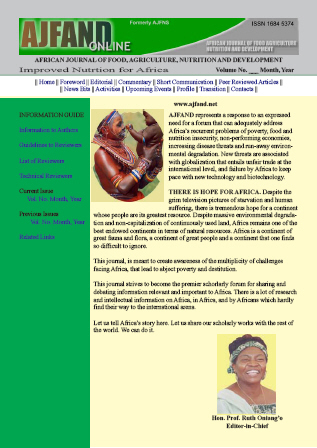
|
African Journal of Food, Agriculture, Nutrition and Development
Rural Outreach Program
ISSN: 1684-5358
EISSN: 1684-5358
Vol. 17, No. 4, 2017, pp. 12817-12836
|
 Bioline Code: nd17097
Bioline Code: nd17097
Full paper language: English
Document type: Research Article
Document available free of charge
|
|
|
African Journal of Food, Agriculture, Nutrition and Development, Vol. 17, No. 4, 2017, pp. 12817-12836
| en |
RED PALM OIL BEAN-STEW IMPROVED SERUM VITAMIN A AND HAEMOGLOBIN CONCENTRATIONS AND ANTHROPOMETRIC INDICATORS OF SCHOOL CHILDREN WITH LOW VITAMIN A CONCENTRATIONS IN A MALARIA-ENDEMIC SETTING
Egbi, G; Alatiah, GA; Ayi, I & Steiner-Asiedu, M
Abstract
Vitamin A deficiency (VAD), anaemia, and parasitic infections are among the major
nutritional and health problems confronting Ghanaian school children. This study
assessed the impact of red palm oil bean-stew consumption on serum retinol and
haemoglobin concentrations of Ghanaian school children in a malaria-endemic setting.
The design was a pre-post nutrition intervention study. It involved 142 6-12 year-old
children. Participants were selected by simple random sampling. After baseline sample
and data collection, the participants consumed red palm oil bean-stew with gari (made
from fermented, grated cassava flour), three times a week for a period of six months.
Final biological samples and data were collected as at baseline. Dietary data were
collected using Food Frequency Questionnaires and the 24-hour recall procedure.
Serum retinol was measured with High Performance Liquid Chromatography and
haemoglobin by Haemocue Haemoglobinometer. Malaria parasitaemia and hookworms
were examined by microscopy from blood films and stool samples using the Giemsa-staining
and Kato-Katz techniques, respectively. Data were analysed with Statistical
Package for Social Sciences version-23. Mean values for outcome variables were
compared between baseline and final using paired t-tests. Results indicated that majority
of the participants (82.4%) consumed cereals. Many of them also (98.6%) never
consumed dairy or dairy products. Mean serum retinol concentration was 12.1 ±
6.6μg/dl during baseline and 16.2 ± 6.4μg/dl at final, the difference significant at
p<0.05. The mean haemoglobin concentration at baseline was 119.4 ± 10.6 g/l and
126.0 ± 9.34g/l at final, with a significant difference at p<0.05. The prevalence of VAD
defined as serum retinol concentration <20μg/dl was 76.2% at the end of the study being
significantly different from that at baseline (93.6%), p<0.05. Prevalence of anaemia was
30.3% and 11.3% at baseline and final, respectively with a significant difference at
p<0.05. Malaria parasitaemia was prevalent: 67.6 % at baseline and 62.7% at the end of
the study. Only one participant (0.01%) was found with hookworm infestation. For
participants with VAD, 48.3% and 36.2% improved to moderate and normal vitamin A
status, respectively at the end of the study. The prevalence of anaemia among VAD
participants was 36.2 % at baseline and 12.1 % at final. In conclusion, red palm oil bean-stew
consumption increased the haemoglobin concentration and minimized prevalence
of anaemia among the study participants. It also increased serum retinol concentrations
and minimized the prevalence of vitamin A deficiency (especially severe vitamin A
deficiency) among the study participants.
Keywords
Red palm oil; Vitamin A; Haemoglobin; School children; Malaria; Parasitaemia
|
| |
© African Journal of Food, Agriculture, Nutrition and Development
Alternative site location: http://www.ajfand.net/
|
|
